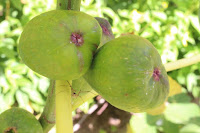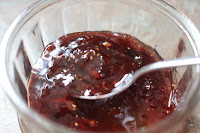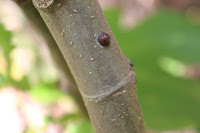Plant Profiles: Figs
 |
| Our fig tree ('Brown Turkey') - it's starting to look a little autumnal in the garden. |
The weather's finally turned chilly this week, so we're facing proper autumn at last. It's a shame because I'd half-hoped my fig tree's second crop of the year would have time to ripen for once. In my heart I knew it's only a dream, but if I could move my ginormous tree inside for protection I'd increase my chances greatly.
As you can see that's not going to happen, would you believe that whole tree is housed in a pot two feet wide and three feet tall? It proves the guidance on root restriction really does help fig trees to thrive, but alas it's destroyed my chance of enjoying their main crop of the year. It's said they taste even better than the over-wintered breba crop.
The fruit form on the season's new growth, which means it's time to take my tree in hand as much of that was out of reach this year, much to the delight of the local squirrels. I also managed a superb crop of ground touching fruit, so somewhere in the garden there are some very happy slugs and snails who got to most of the hidden treasure before I did.
Despite that, it's been a bumper year for figs, which allowed me to play around with some different recipes for my produce for a change. I usually only have enough to indulge my late summer breakfast treat of fresh figs with organic Greek-style yoghurt. Here's what I've been having instead...
A quick recipe - fig jam
I've adapted my recipe for rhubarb and ginger jam to make one of the most delicious jams I've ever tasted. As figs are sweet, I used half the weight of sugar to that of the fruit, just the fresh ginger to give the jam a gentle kick, plus the juice of 1 lemon to help with the set as figs are low in pectin.
The result is fairly sloppy, so it should be eaten up within a couple of months. That shouldn't be a problem as this jam really is that good.
You may also like to try my recipe for Figgy Cheese Tart - another match made in heaven.
Cultivation notes
You may need some patience before your fig tree bears fruit. I bought mine in 2008 and it didn't really get going - growth and fruit-wise - until around 3 years ago. I'm growing mine by next door's west facing garage wall which provides plenty of the warmth needed for growing outside. You may prefer to grow yours in a conservatory or greenhouse and I really should cover my outdoor fig with fleece when severe frost threatens.
It's time to pick off this season's fruit as they won't ripen - watch out for the plant's milky sap when you do this, as it can irritate the skin. I can already see some pea-like embryonic fruit which will form next year's crop. I've found I need to ensure these get plenty of water if there's a dry spell in the spring/early summer, otherwise they fall off and I stand to lose around 50% of them.
 |
| Immature fruit |
Figs are a fascinating plant - the flowers are never seen as they're encased within the fruit. You may have read that the flowers are fertilised by a wasp, which enters the fruit via the 'eye' at the base. This doesn't happen with UK-grown cultivars and the plants are said to be parthenocarpic i.e. producing fruit without the need for the fertilisation of the flowers first.
It's easy to tell when figs are ripe. They soften and change colour to brown or black, plus they start to droop via their 'neck' which attaches them to the stem. There may also be a droplet of sugar exuding from the fruit's eye. I've found this usually attracts the attention of the local ant population when it happens, and it's often helped me to find some fruit I might otherwise have missed.
My fig's been relatively pest-free so far, but I've noticed lately some of the branches have scale insects. I need to give my tree a renovation prune, so I'll inspect the remaining branches and squish any of them I find. This pruning means I stand to lose most - if not all - of next year's crop.
You may also like:
- The RHS's guidance on growing figs and recommended cultivars for the UK. Note that figs only fruit reliably in southern England. However, they're still a wonderful plant to consider for elsewhere in the UK, particularly if you're looking for an exotic touch to your garden
- Reads Nursery's page on fig facts and lore
- Steven Frank's scientific paper on the behaviour and morphology of fig wasps (NB pdf file)
- Hortscience's overview - lots of history, biology, breeding and production information
- The RHS's guide to fan trained pruning - great for growing a fig tree in a tighter spot. Thanks to Brian's comment for the reminder (BTW you should check out his great blog)
Latin without tears
The latin name for the edible fig is Ficus carica; Ficus is the actual ancient latin name for fig and carica refers to Caria, an ancient region of south-western Turkey, where it's a native plant.
The edible fig hails from ancient Persia, where it formed one of the earliest (if not the earliest) cultivated plants. Evidence of cultivation dates back to 9400 BC, and it pre-dates the cultivation of wheat by around 1,000 years.
Plant Profiles is sponsored by Whitehall Garden Centre.
Note to readers: sponsorship goes towards my blogging costs, the words are my own. There are no affiliate links or cookies associated with this post.














Lovely to see your fig tree. I have a big crop of not-yet-ripe figs as well that I need to remove.
ReplyDeleteThanks CJ - I've seen quite a few fig trees due for fruit removal this week.
DeleteI do like fresh figs. I wish I had planted one here when we laid out the garden, there doesn't seem to be any room for one now!
ReplyDeleteThanks for the reminder to add a link to fan training trees, Brian!
DeleteAs you know I'm Tree Following a fig this year so found this post of interest. Flighty xx
ReplyDeleteThanks Flighty and congratulations on reaching your 1,000th post :)
DeleteThat's a rather splendid plant! I keep toying with the idea of growing one in our sheltered back garden, and at least if I grow one in a pot I can move it when we finally have the dosh to replace the patio with something less 70's (it is pink and grey chequerboard concrete slabs...)
ReplyDeleteYou need to have a chat to Karen, Janet. She has (or had?) one in her garden at Dyffryn, so will be able to advise on whether it's viable for you on Anglesey.
DeleteI was 45 before I planted my first fig tree in our yard. It is an Italian honey fig. I had just moved to California from Alaska with my husband and two teen daughters. I was so excited to plant fruit trees in our near 1/4 acre backyard. Our fig was a great success. I’ve shared hundreds of figs from that tree with friends, family and coworkers. Soon after we got the fig tree I learned how easy it is to clone it. (In spring, cut 12 inches from a healthy, leafless branch, dip in root hormone, plunge a shovel handle into a pot of planting soil to create a tunnel for the root, carefully insert the root so as not to brush off rooting hormone, and gently backfill with potting soil.— I found this method works for grapevines also.) I propagated two fig branches last spring in this manner and 8 months later they have sprouted vigorously. One clone is sporting three juicy looking figs! I read that figs do not need to be grafted onto rootstock, so once you are certain your fig baby has developed a strong root system you can plant it into a larger pot for a year or two to gain more roots and strength before planting in a permanent location, if desired. I gifted a fig cloned five years ago in this manner to a friend and last year he boasted a harvest of 50 figs from his fig tree that has languished in a five gallon nursery pot. If you try this, please do read up on fig tree care and preferred soil as I am not an authority on such things. You will want to know how to give your clone your very best effort in order to successfully grow a healthy fig tree.
ReplyDelete